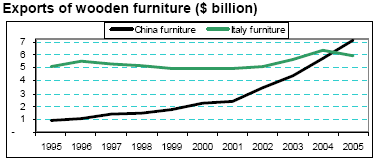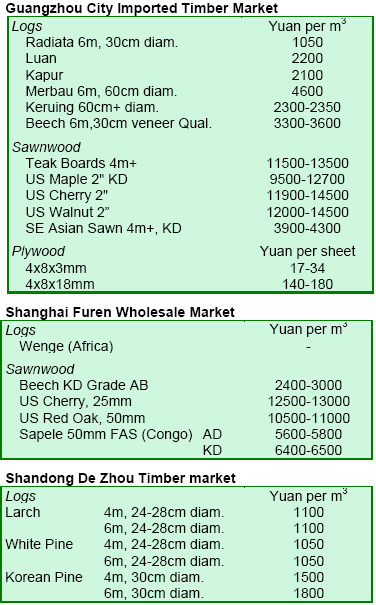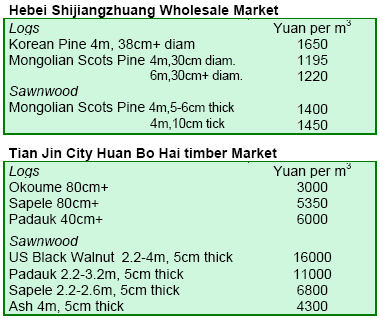US Dollar Exchange Rates of 30th Oct. 2006
China Yuan 7.874
Report from China
Chinese manufacturers to push plywood prices up
Further price hikes were under discussion on the market for Chinese plywood, according to
Euwid. Analysts expected prices for all plywood ranges to be raised by up to 5% over the
next few months, starting early 2007. The new price increases were intended to offset
rising costs of
upstream products and the upcoming reduction in export subsidies in China. Chinese plywood
suppliers wanted to pass on the rising resin, film, and veneer prices as well as the
reduction in export subsidies from 13% to 11% (see TTM 11:18) to export prices. Meanwhile,
Chinese
poplar-pine plywood had been recently affected by declining prices for Brazilian elliotis
pine plywood (see Report from Brazil). Chinese suppliers had been forced to lower slightly
sales prices to remain competitive.
China overtakes Italy as largest furniture exporter
The latest statistics from UN Comtrade confirm that China (including Hong Kong and Macao
S.A.R.s ) became the world¡¯s largest exporter of wooden furniture in 2005, overtaking
Italy from its long held position (see chart). China has maintained an impressive upward
trend in furniture production driven by strong growth in both furniture exports and
domestic consumption. From 1995 to 2005, the total value of wooden furniture exports rose
seven-fold from $932 million to $7.15 billion, and wooden furniture exports accounted for
only about one-quarter of China¡¯s total furniture output in 2005. China¡¯s furniture
was exported mainly to the USA (around 50% of all
exports), the EU and Japan, with substantial re-exports reported by Hong Kong as a transit
through its S.A.R. China also replaced Canada as the leading supplier of furniture to the
USA in 2001.

Italy¡¯s furniture exports were relatively stable at
around $5 billion between 1995 and 2002. Italian SPWP exports were affected by recurring
unfavourable euro/dollar exchange rates during this period and strong competition from
China, Poland and elsewhere which led to widespread decreases in market share. Despite
these market share declines, Italy¡¯s exports surged in 2003-2004 but again retreated in
2005 when it was overtaken by China. Upholstered furniture and chairs constituted the main
type of wooden furniture exported by Italy.
China¡¯s booming furniture exports drove those of secondary processed wood products
(SPWP) to over $11.4 billion in 2005, consolidating China¡¯s position as the world¡¯s
largest exporter of SPWP. China displaced Italy from the top position in 2003.
Impact of China on UNECE region marketplace
The UNECE Timber Committee (TC) analyzed recently the forest products market situation
with a particular focus on China¡¯s influence on the UNECE market. The following is an
extract from the official text.
UNECE forest products markets achieve record levels
Forest products markets in the UNECE region achieved record levels in 2005 and the TC
forecasts continued growth in 2006 and 2007. The meteoric rise of China¡¯s forest
industry and its unprecedented impact on world markets, presents challenges and
opportunities to both
market players and policy makers, as do other factors such as climate change, high energy
prices and public concern about unsustainable forest practices. Taken together, these
influences are fostering a major reshaping of the marketplace. One effect of this has been
increased competition for raw materials, which has raised prices significantly for some
industries.
China is the world¡¯s largest exporter of forest products
China has rapidly become the world¡¯s largest exporter of forest products in value
terms, and is second only to the USA as an importer. China¡¯s own forests meet only a
small part of its industrial roundwood appetite, with the result that China is now the
world¡¯s number one importer
of logs, both softwood and hardwood. Russia is the main source of softwood logs, supplying
about 70% of China¡¯s needs. A small part of China¡¯s imports is of certified origin
but it does seem that a significant share might be from illegal sources. According to
official Russian
sources, China imports 19.2 million m3 of logs from Russia, but Russian experts estimate
that in addition to that volume there is a significant supply of logs from the Far East
region of Russia which is derived from illegal logging.
Investments in Chinese mills and transportation, aided by government incentives, have led
to a huge expansion in value-added processing, especially furniture, millwork and
mouldings. Over the last decade China¡¯s furniture exports have grown at a rate of 34%
per year and China is by far the major supplier of furniture to the USA, and second only
to Canada as a supplier of forest products. China¡¯s low-cost labour is balanced by
rising raw material, energy and transportation costs. Competition from low-priced Chinese
wood products is leading to the increasing trade
disputes: complaints have been filed in the USA, Canada, Germany and Italy. Although
exports are escalating, domestic consumption, currently at about 75% of production, is
rising with the standard of living. UNECE region forest products companies are faced with
a rapidly changing marketplace: some are successful in profiting from investments in and
trading with China, while others that were not able to adapt have reduced revenues.
Chinese furniture and flooring flood UNECE countries
There has been phenomenal growth in the level of furniture exports from China and
Southeast Asia into the five major importing countries, US, France, Germany, UK and Japan.
The world furniture trade has opened up faster and more profoundly than anticipated and
the impact on
manufacturers in the USA in particular, has been severe. Chinese labour costs are low,
their large-scale enterprises are highly efficient and final quality is also high. China
accounts for 43% of US wood furniture imports and 33% of Europe¡¯s. China may now be the
world¡¯s number one
furniture exporter, unseating Italy from its long-held position. Similar impacts are being
witnessed in the flooring sector. Wood has increased its share of the flooring market in
Europe, but faces stiff competition from non-wood products as well as imported flooring.
In terms
of parquet flooring, for instance, China has increased its market share from about 10% in
2000 to over 35% in 2005. In response to these pressures, a marketing campaign to promote
¡°real wood¡± flooring is being launched to raise consumer awareness and to encourage
demand, in competition against other flooring materials.
China refunds VAT on products made of residues
China¡¯s Ministry of Commerce and the State Administration of Taxation have jointly
issued a notice on collection and refund of value-added tax (VAT) on products made of
timber residues and inferior fuelwood. The measure, in effect from 1 January 2006 to 31
December 2008, has been taken to encourage the full use of timber resources and develop
integrated utilization of
timber.
The measure benefits products made from three kinds of timber residues, including logging
remains (e.g. branches, tips, barks, leaves, roots, canes and shrubs and bucking ends) and
processing residues (e.g. slab, lath, wood and bamboo ends, sawndust, smash veneer, wood
core, shaving and wood blocks). Inferior fuelwood include secondary processed logs of very
low quality, small diameter timber such as small log strips, pine pole, wood pole and
short logs of length shorter than 2m and diameter smaller than 8cm. The notice also
stipulates that taxpayers should ensure that the products meet approved quality standards
before applying for the VAT refund.


|